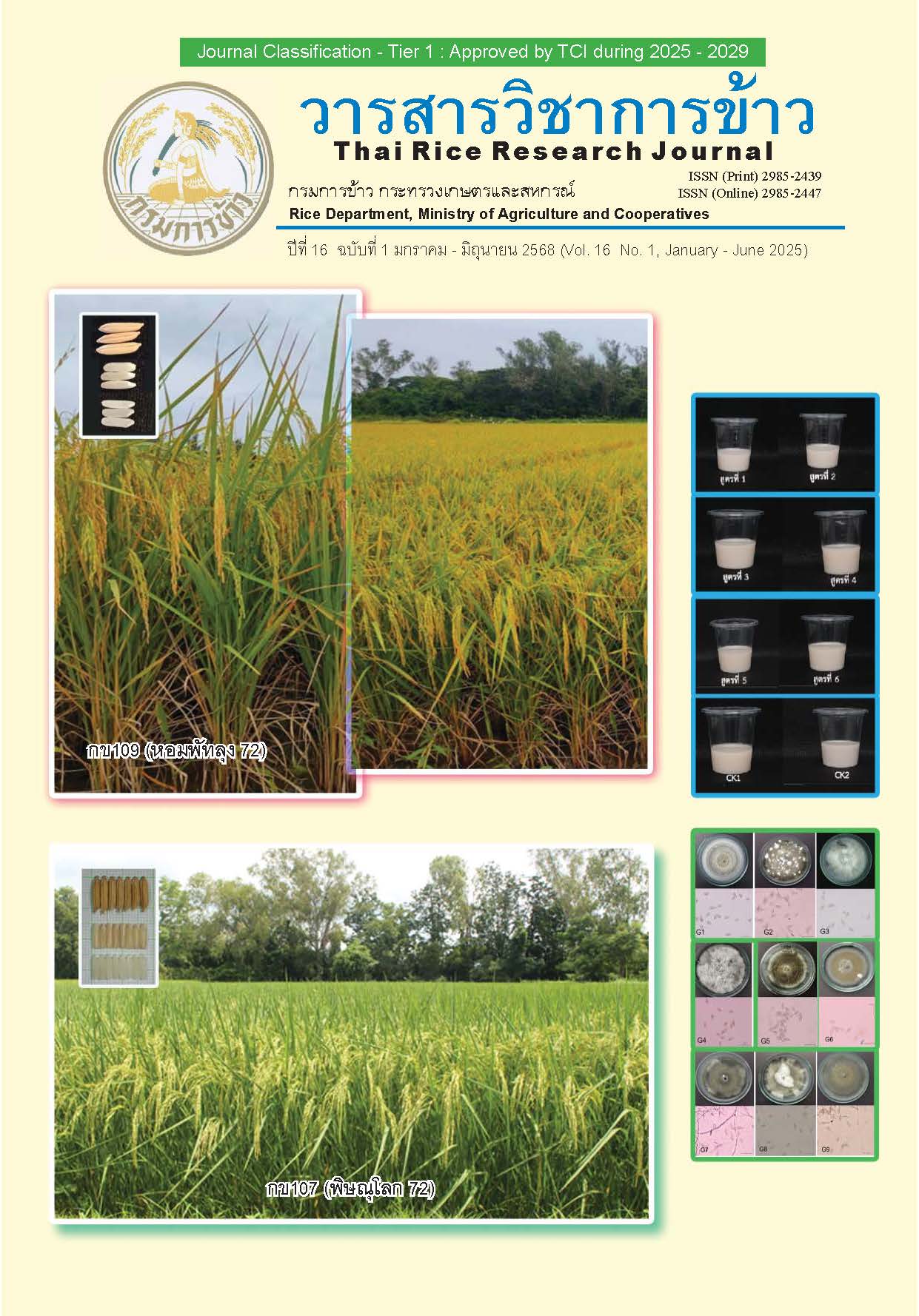การคัดเลือกข้าวทนแล้งโดยใช้ปริมาณสาร Malondialdehyde
Main Article Content
บทคัดย่อ
ข้าว เป็นพืชที่ใช้น้ำปริมาณมากในการเพาะปลูก แต่ปัจจุบันพื้นที่เพาะปลูกข้าว กำลังประสบปัญหาการเปลี่ยนแปลงสภาพอากาศและขาดแคลนน้ำสภาพแล้งส่งผลให้เกิดความเครียดในทางกายภาพซึ่งเป็นปัญหาที่สำคัญที่ทำให้ผลผลิตตลอดจนคุณภาพข้าวลดลง การปรับปรุงพันธุ์ข้าวทนแล้งจึงเป็นกลยุทธ์ที่สำคัญในการรับมือกับปัญหาภัยแล้ง ซึ่งการปรับปรุงพันธุ์จะประสบความสำเร็จได้จำเป็นต้องมีเครื่องมือตลอดจนดัชนีชีวัดความทนแล้งในข้าวที่มีความแม่นยำ งานวิจัยนี้มีวัตถุประสงค์ในการวิเคราะห์และใช้ปริมาณมาลอนไดอัลดีไฮด์ (Malondialdehyde (MDA)) ควบคู่ไปกับการให้คะแนนการม้วนของใบข้าวเป็นเครื่องมือในการคัดเลือกสายพันธุ์ข้าวทนแล้ง โดยทำการวิจัยในชุดประชากรข้าวที่ได้จากการผสมพันธุ์เชิงเดี่ยวระหว่างข้าวพันธุ์ IR57514 และพันธุ์ขาวดอกมะลิ 105 จำนวน 224 สายพันธุ์ เปรียบเทียบกับพันธุ์มาตรฐาน พันธุ์ทนแล้ง IR57514 และพันธุ์ทนแล้งปานกลาง IR1552 ขาวดอกมะลิ 105 และขาวปากหม้อ 148 ปลูกข้าวทดสอบในสภาพที่มีการให้น้ำปกติ และสภาพแล้ง วิเคราะห์ปริมาณ MDA ควบคู่กับการประเมินการม้วนของใบข้าวเมื่อทดสอบในสภาพแล้งในข้าวระยะแตกกอ ดำเนินงานที่ศูนย์วิจัยข้าวอุบลราชธานี และสถาบันวิทยาศาสตร์ข้าวแห่งชาติ ระหว่างเดือนตุลาคม 2565 - กันยายน 2566 พบว่า ในสภาพการให้น้ำปกติ ข้าวทดสอบทั้งหมดมีการม้วนของใบอยู่ในระดับ 1 และมีปริมาณ MDA อยู่ในช่วง 3.56-7.00 μmol/g FW เมื่อข้าวชุดนี้อยู่ภายใต้สภาพแล้ง ปริมาณ MDA จะเพิ่มขึ้น อยู่ในช่วง 8.85-30.35 μmol/g FW และสายพันธุ์ข้าวส่วนใหญ่มีระดับการม้วนของใบอยู่ในระดับ 5 แต่มีสายพันธุ์ PSL99094-350-9-5R-21, PSL99093-108-3-5R-40, PSL99094-72-8-5R-2, PSL99093-108-4-5R-38, PSL99094-13-5-5R-25, PSL99094-32-1-5R-21 และ PSL99094-159-7-5R-21 มีปริมาณสาร MDA อยู่ในช่วง 8.86 ถึง 11.07 μmol/g FW และ มีระดับการม้วนของใบเมื่อขาดน้ำอยู่ที่ระดับ 1 เช่นเดียวกันกับข้าวที่ปลูกทดสอบในสภาพน้ำปกติ ทั้งยังพบว่าพันธุ์มาตรฐานทนแล้ง IR57514 เมื่อเผชิญสภาพแล้งมีปริมาณ MDA 12.10 μmol/g FW และมีการม้วนของใบระดับ 2 ผลการทดลองครั้งนี้ยังชี้ให้เห็นว่า สายพันธุ์ข้าวที่มีการม้วนของใบในระดับต่ำบางสายพันธุ์กลับมีปริมาณ MDA สูงในระดับเดียวกับกลุ่มที่มีระดับการม้วนของใบในระดับสูง ดังนั้นการใช้คะแนนการม้วนของใบข้าวในการคัดเลือกข้าวทนแล้งจึงอาจไม่ใช่วิธีการทีแม่นยำเพียงพอ ในขณะที่ปริมาณ MDA มีความสัมพันธ์โดยตรงกับกลไกการต้านอนุมูลอิสระซึ่งเป็นกลไกสำคัญที่ทำให้ข้าวมีความสามารถในการทนแล้ง และยังมีความสัมพันธ์กับระดับการม้วนของใบข้าว ดังนั้นจึงสามารถใช้ปริมาณ MDA เป็นตัวบ่งชี้ความสามารถในทำงานของกลไกต้านอนุมูลอิสระในข้าวที่ปรับตัวในสภาพเครียดจากความแล้งได้ดี และใช้เป็นเครื่องมือในการคัดเลือกเพื่อปรับปรุงพันธุ์ข้าวทนแล้งให้มีประสิทธิภาพมากขึ้น
Article Details
เอกสารอ้างอิง
Alou, I.N., J.M. Steyn, J.G. Annandale and M. Van Der Laan. 2018. Growth, phenological, and yield response of upland rice (Oryza sativa L. Cv. Nerica 4) to water stress during different growth stages. Agricultural Water Management 198 (February): 39-52.
Alvarez, J.M., J.F. Rocha and S.R. Machado. 2008. Bulliform cells in Loudetiopsis Chrysothrix (Nees) conert and Tristachya Leiostachya Nees (Poaceae): structure in relation to function. Brazilian Archives of Biology and Technology 51(1): 113-19.
Boonjung, H. and S. Fukai. 1996. Effects of soil water deficit at different growth stages on rice growth and yield under upland conditions. 2. Phenology, biomass production and yield. Field Crops Research 48(1): 47-55.
Bunnag, S. and P. Pongthai. 2013. Selection of rice (Oryza sativa L.) cultivars tolerant to drought stress at the vegetative stage under field conditions. American Journal of Plant Sciences 04(09): 1701-1708.
Davatgar, N., M.R. Neishabouri, A.R. Sepaskhah and A. Soltani. 2012. Physiological and morphological responses of rice (Oryza sativa L.) to varying water stress management strategies. International Journal of Plant Production 3(4): 19-32.
Fen, L.L., M.R. Ismail, B. Zulkarami, M.S. Rahman and M.R. Islam. 2015. Physiological and molecular characterization of drought responses and screening of drought tolerant rice varieties. Bioscience Journal 31(3): 709-718.
Gunnula, W., N. Kanawapee, P. Somta and P. Phansak. 2022. Evaluating anatomical characteristics associated with leaf rolling in northeastern Thai rice cultivars during drought by decision tree. Acta Agrobotanica 75 (December).
Gutiérrez-Martínez, P.B., M.I. Torres-Morán, M.C. Romero-Puertas, J. Casas-Solís, P. Zarazúa-V, E. Sandoval-Pinto and B.C. Ramírez-Hernández. 2020. Assessment of antioxidant enzymes in leaves and roots of phaseolus vulgaris plants under cadmium stress//Evaluación de enzimas antioxidantes en hojas y raíces de plantas Phaseolus vulgaris bajo estrés de cadmio. Biotecnia 22(2): 110-118.
Hossen, M. 2017. Comparative physiology of salinity and drought stress tolerance in indica and japonica rice seedlings. Sher-e-Bangla Agricultural University.
IRRI. 2014. Standard Evaluation System for rice (SES). 5th eds., International Rice Research Institute, Los Baños, Philippines. 57 p.
Jarin, A.S., M.M. Islam, A. Rahat, S. Ahmed, P. Ghosh and Y. Murata. 2024. Drought stress tolerance in rice: Physiological and biochemical insights. International Journal of Plant Biology 15(3): 692-718.
Ji, K., Y. Wang, W. Sun, Q. Lou, H. Mei, S. Shen and H. Chen. 2012. Drought-responsive mechanisms in rice genotypes with contrasting drought tolerance during reproductive stage. Journal of Plant Physiology 169(4): 336-344.
Ma, Y., E. Agathokleous, Y. Xu, R. Cao, L. He and Z. Feng. 2024. Cultivar-specific regulation of antioxidant enzyme activity and stomatal closure confer tolerance of wheat to elevated ozone: A two-year open-field study with five cultivars. Plant Stress 12(June): 100479.
Mader, A., M. Langer, J. Knippers and O. Speck. 2020. Learning from plant movements triggered by bulliform cells: The biomimetic cellular actuator. Journal of The Royal Society Interface 17(169): 20200358.
Pamuta, D., M. Siangliw, J. Sanitchon, J. Pengrat, J.L. Siangliw, T. Toojinda and P. Theerakulpisut. 2022. Physio-biochemical traits in improved KDML105 jasmine rice lines containing drought and salt tolerance gene under drought and salt stress. Chilean Journal of Agricultural Research 82(1): 97-110.
Sruthi, P., U. Surendran, H.M. Siddiqui and S. Alamri. 2024. Understanding the leaf rolling of paddy and exploring its management options under aerobic rice. Scientific Reports 14(1): 19335.
Velikova, V., I. Yordanov and A. Edreva. 2000. Oxidative stress and some antioxidant systems in acid raintreated bean plants. Plant Science 151(1): 59-66.
Wang, X., J. Huang, S. Peng and D. Xiong. 2023. Leaf rolling precedes stomatal closure in rice (Oryza sativa) under drought conditions. J. Lunn (ed.). Journal of Experimental Botany 74(21): 6650-6661.
Zhang, Y., Q. Luan, J. Jiang and Y. Li. 2021. Prediction and utilization of malondialdehyde in exotic pine under drought stress using near-infrared spectroscopy. Frontiers in Plant Science 12 (October): 735275.

